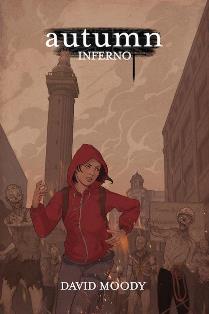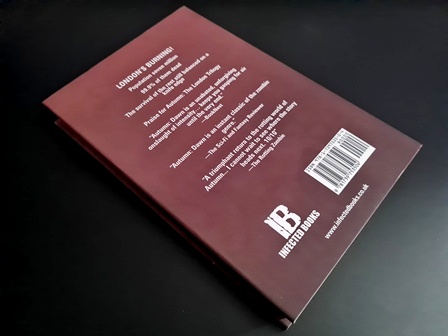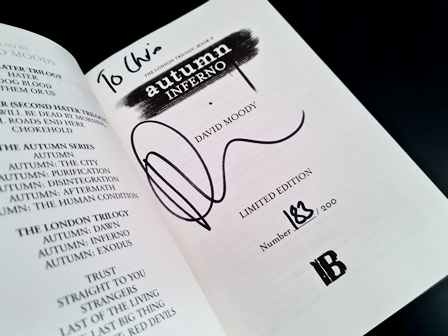
First published back in January of 2022, David Moody’s novel ‘Autumn: Inferno’ formed the second book in the ‘London Trilogy’, which was a separate spinoff trilogy from the author’s original ‘Autumn’ series.
The trilogy was first released as limited edition hardbacks of two-hundred hand-numbered copies. The limited edition hardbacks each contained bonus material at the end of the books, where Moody provides a handful of candidly written pages offering a heap of insight into the writing behind the ‘Autumn’ books.
Following the individual publications of the three ‘London Trilogy’ books, in October 2023 an omnibus edition was released which collected together all three instalments, along with additional short stories from the series, into one giant 840 page edition.
DLS Synopsis:
At more than three-hundred-and-fifty survivors, the combined group at the Monument Base was the largest group of survivors for countless miles, if not the whole country. In the four weeks since the two groups had converged along the bank of the river Thames, together they’d shored-up their defences around the Monument and surrounding the Tower of London. Once the perimeter had been sealed, the relentless violence and bloodshed had, thankfully, finally come to an end.
However, with such a large group of survivors, meant a lot of mouths to feed. They hadn’t had time to stockpile supplies before locking down the base. Although they’d done what they could to try and eke out their supplies, they’d known it was only a matter of time before the well ran dry.
They were now crammed within a sliver of space, about half a square mile in area. Ever since the group from the hotel had joined those at the Monument, they’d been focussed on protecting the base and keeping it secure. Now the time had come to start reclaiming some of what they’d lost. Clawing back land and supplies which the lone wolf – Taylor – had handed back to the dead.
Teams of clean-up crews and scavengers were now going from building to building. They would invariably find misery and decay in almost every building. But they had to deal with it. Removing all corpses quickly and efficiently. Human remains are to be treated the same as any other rubbish. There’s no time for dignity and respect now. They simply need to get the job done.
However, Dominic Grove was painfully aware of the hardship the approaching winter months would bring. They needed to find enough supplies to last out the cold winter months. But stock levels were low, and the scavenging wasn’t bringing in enough. They needed another plan.
And then their eyes turn to Surrey Quay along the south bank of the Thames. It had a shopping centre with enough food to keep them fed for months, maybe even right the way through the winter. But that was on the other side of the Thames. A considerable distance in this undead world.
But they had to try. The opportunity was too good to not. However, the risks were high. And despite what Piotr said, they still had Taylor to contend with…
DLS Review:
When reading the first instalment in the trilogy – ‘Autumn: Dawn’ (2021) – it became abundantly clear that the three instalments were very much intended to be read together as a continuous story, divided into three books, rather than three discrete stories sitting shoulder-to-shoulder.
Accordingly, this second instalment begins straight from where Book One left off, and we’re flung headfirst into Day 72, with the group at the Monument Base trying to rebuild from the devastation Taylor had unleashed upon their base.
Indeed, the first quarter-or-so of this book reads as a textbook post-apocalyptic rebuild story, with group politics and troublesome attempts at forward planning weighing heavy on the unfolding narrative. And of course, this is all escalated further because of the pressure-cooker environment they’re placed within.
As with the first book, once again we don’t have any singular characters striding towards the forefront of the tale, where they might become the key protagonists to latch onto. Instead, we have a handful of survivors who we’ve come to know, collectively telling the tale through their individual movements and decisions.
One thing that stands out from the novel is the way Moody seems to have pulled back somewhat from the urgency within it. That’s not to say there aren’t times when the storyline isn’t racing ahead at full pelt, with a high-octane chapter or two throwing down bouts of violence and bloodshed. However, the overall pacing, and indeed mood of the piece, does feel more reserved, more planning, politics and preparation.
Thrown in are some definite nods to Romero’s classic ‘Dawn Of The Dead’ (1978). Not just with the huge-haul scavenging at the Surrey Quay shopping centre, but also with much of the premise behind the overarching narrative. In fact, when you take a minute to reflect back upon the overall plot, you’ll find a number of similarities between the premise of Dawn and that of these ‘London’ books.
However, one of the key aspects brought into the novel, is with the gradual progression of the undead’s condition and their evolving collective abilities. This is an ethos which became a fundamental part of the original ‘Autumn’ books. A concept which is again echoed in the ‘London’ books, although here in the much tighter confines of a major city.
With this we get to see how the dead are gradually becoming more self-aware. As the storyline progresses, we start seeing the first signs of the undead regaining some small degree of control. And with that, the dead start becoming more and more of a threat. Their actions become more violent. More targeted. More focused on the movements, sounds and existence of the survivors. Indeed, this gradual evolution sets the backdrop for the entirety of this second book.
Outside of this, for me, some of the highlights of this instalment were with the power struggle between many of the characters, in particular the thuggish hothead – Piotr – as well as the untrustworthy ex-politician Dominic Grove. We also see far more of Vicky, Selena, Omar, David and Stan as well as the surprising return of some characters whom we’d pretty much written off.
I guess if you were to categorise this second book in the trilogy, you’d probably put it as the instalment that set down the foundations for what’s surely to come in the final book and established the direction for individual character narratives. Yes, we have plenty going on within the book, however, there’s no singular story taken from start-to-end. Instead, this is very much a connecting novel. One where the existing storylines are taken further, taken into different directions, and woven into the final segments of this middle-section, ready for the culmination of all these events to explode in the final instalment.
As such, this instalment is one which deals with ensuring the readers are now truly invested into the characters. As such, some causal readers might perhaps be a tad disappointed with how little within this particular book is taken to conclusion. There really is no element of a standalone story within this. It’s building blocks and foundation setting, along with further character establishing and plot development.
The book does however contain some pretty grisly, grotesque and downright repulsive imagery of undead transmutation, as the corpses interlock and fuse together from the constant compression of the surging dead. We’re talking huge spans of decaying flesh, compressed together to become a sort of vile undead mutation. Blocks of rotten flesh with arms and legs undiscernible from the bodies they were once a part of. Honestly, this stuff is as gut-churning as it is incredibly imaginative and wonderfully considered.
The novel runs for a total of 286 pages.
Evolution Of The Dead – 10 Pages
[Limited Edition Hardback – Bonus Material]
The book ends with a short but incredibly insightful commentary from Moody in which he details his thinking behind the ‘Autumn’ novels, his aims for the ‘London’ books, as well as his thoughts about the zombie genre as a whole.
Here we see Moody waxing lyrical about zombie flicks titled ‘… Of The Dead’ (outside of Romero’s highly-revered original three zombie films that is!). Moody provides us with an insight into his writing of the original books, his motivation behind the ‘London’ books, and what came with moving away from the wandering zombie and instead putting the books’ premise into a highly-populated location – ala Central London.
As part of this Moody examines the herding of the undead. How to an outside observer it would appear that the undead are all acting under a common goal. However, Moody explains how this is instead the individual instinct of the undead kicking in. How they’re not herding but following.
It’s an interesting piece and one which shows just how much thought Moody puts into his novels and the entire zombie premise. We’re talking a near obsessive amount of pondering and deliberation about what would likely occur. Personally, I think it’s magnificent how much he’s considered and then brought into these books.

© DLS Reviews
Other ‘Autumn’ instalments:
- ‘Autumn’ (2001)
- ‘Autumn: The City’ (2003)
- ‘Autumn: Purification’ (2005)
- ‘Autumn: The Human Condition’ (2005)
- ‘Autumn: Disintegration’ (2011)
- ‘Autumn: Aftermath’ (2012)
- ‘Autumn: Dawn’ (2021)
- ‘Autumn: Inferno’ (2022)
- ‘Autumn: Exodus’ (2023)
- ‘Autumn: The London Trilogy Omnibus’ (2023)










